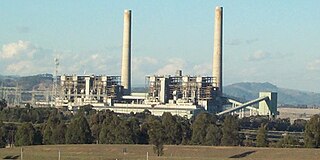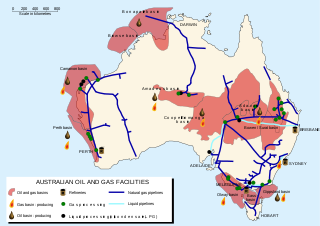
Iberdrola is a multinational electric utility company based in Bilbao, Spain. It has around 40,000 employees and serves around 30 million customers.

Liddell Power Station is a decommissioned coal-fired thermal power station that had four 500 megawatts (670,000 hp) EE steam-driven turbine alternators, providing a combined electrical capacity of 2,000 megawatts (2,700,000 hp).
Redbank Power Station is a biomass power station located in Warkworth, in the Hunter Valley of New South Wales, Australia. The station is currently awaiting a restart of operations after converting from its original use as a coal-fired power station. Redbank is unique for its utilisation of circulating fluidised bed technology, the only generator of its kind in Australia. Upon re-fire, the station will operate using 100% biomass at a capacity of 151MW of electricity.

Wind power, a form of renewable energy harnessed through wind turbines, stands as a pivotal contributor to Australia's energy landscape. With a total installed wind capacity reaching approximately 9,100 megawatts (MW) as of October 2023, wind power constitutes a significant portion, representing 5% of Australia's total primary energy supply and a substantial 35% of its renewable energy supply. Australia's geographic disposition favors the proliferation of wind energy infrastructure, particularly in the southern regions of the nation and along the slopes of the Great Dividing Range in the east. Approximately half of Australia's wind farms are located near coastal regions.

Solar power is a major contributor to electricity supply in Australia. As of December 2023, Australia's over 3.69 million solar PV installations had a combined capacity of 34.2 GW photovoltaic (PV) solar power. In 2019, 59 solar PV projects with a combined capacity of 2,881 MW were either under construction, constructed or due to start construction having reached financial closure. Solar accounted for 12.4% of Australia's total electrical energy production in 2021.

The energy policy of Australia is subject to the regulatory and fiscal influence of all three levels of government in Australia, although only the State and Federal levels determine policy for primary industries such as coal. Federal policies for energy in Australia continue to support the coal mining and natural gas industries through subsidies for fossil fuel use and production. Australia is the 10th most coal-dependent country in the world. Coal and natural gas, along with oil-based products, are currently the primary sources of Australian energy usage and the coal industry produces over 30% of Australia's total greenhouse gas emissions. In 2018 Australia was the 8th highest emitter of greenhouse gases per capita in the world.

The production of renewable energy in Scotland is a topic that came to the fore in technical, economic, and political terms during the opening years of the 21st century. The natural resource base for renewable energy is high by European, and even global standards, with the most important potential sources being wind, wave, and tide. Renewables generate almost all of Scotland's electricity, mostly from the country's wind power.

Renewable energy in Australia is mainly based on biomass, solar, wind, and hydro generation. Over a third of electricity is generated from renewables, and is increasing, with a target to phase out coal power before 2040. Wind energy and rooftop solar have particularly grown since 2010. The growth has been stimulated by government energy policy in order to limit the rate of climate change in Australia that has been brought about by the use of fossil fuels. Pros and cons of various types of renewable energy are being investigated, and more recently there have been trials of green hydrogen and wave power.

Fortescue is a global metal mining and green energy company headquartered in Australia. Fortescue focused on iron ore mining under the name of Fortescue Metals Group (FMG) until July 2023. As of 2017, Fortescue is the fourth-largest iron ore producer in the world. The company has holdings of more than 87,000 km2 in the Pilbara region of Western Australia, making it the largest tenement holder in the state, larger than both BHP and Rio Tinto.
The Tres Amigas SuperStation was a project proposed in 2009 to unite North America’s two major power grids and one of its three minor grids, with the goals of enabling faster adoption of renewable energy and increasing the reliability of the U.S. grid.
South Australia is a leader in utility-scale renewable energy generation, and also produces gas and uranium for electricity generation. Gas production is mostly concentrated in the Cooper Basin in the state's north-east. Gas is delivered from these fields by pipeline to users interstate and to Port Adelaide where it fuels three separate gas-fired power plants. Uranium is also mined in South Australia, though nuclear power generation is prohibited nationally. The Olympic Dam mine is the world's single largest known deposit of uranium and represents 30% of the world's total uranium resource. Many utility-scale wind farms and solar farms have been commissioned during the 21st century and geology with potential for geothermal energy has also been identified but is yet to be developed.

Ireland is a net energy importer. Ireland's import dependency decreased to 85% in 2014. The cost of all energy imports to Ireland was approximately €5.7 billion, down from €6.5 billion (revised) in 2013 due mainly to falling oil and, to a lesser extent, gas import prices. Consumption of all fuels fell in 2014 with the exception of peat, renewables and non-renewable wastes.

The electricity sector in Australia has been historically dominated by coal-fired power stations, but renewables are forming a rapidly growing fraction of supply. In 2021, Australia's electricity production reached 265 TWh, with coal accounting for 52.9% and natural gas for 18.8%. Renewable sources, comprising solar, wind, hydro, and bioenergy with waste, collectively made up 26.7% of the total electricity generation mix.
Energy in the Faroe Islands is produced primarily from imported fossil fuels, with further contributions from hydro and wind power. Oil products are the main energy source, mainly consumed by fishing vessels and sea transport. Electricity is produced by oil, hydropower and wind farms, mainly by SEV, which is owned by all the municipalities of the Faroe Islands. The Faroe Islands are not connected by power lines with continental Europe, and thus the archipelago cannot import or export electricity.
Neoen is a French producer of exclusively renewable energy headquartered in Paris, France. Founded in 2008, it develops, finances, builds and operates solar power plants, wind farms and energy storage solutions. As at 30 June 2023, the company's total capacity was 7 GW, made up of 47% solar, 34% wind and 19% battery storage. Neoen aims to attain 10 GW in operation or under construction by 2025.

The Murra Warra Wind Farm is one of Australia's largest wind farms. Located on the plains of north-western Victoria, approximately 25 kilometres (16 mi) north of the city of Horsham, it consists of 99 wind turbines with a maximum tip height of 220m.
Green hydrogen (GH2 or GH2) is hydrogen produced by the electrolysis of water, using renewable electricity. Production of green hydrogen causes significantly lower greenhouse gas emissions than production of grey hydrogen, which is derived from fossil fuels without carbon capture.
The Australian Renewable Energy Hub, formerly Asian Renewable Energy Hub (AREH), is a proposal to create one of the world's largest renewable energy plants in the Pilbara region of Western Australia. After several revisions of the original project concept, in January 2023 the Government of Western Australia approved a revised set of seven projects, totalling 26 GW of wind and solar capacity that would be used to produce green hydrogen, to be exported by converting it to ammonia.
Shell Energy Australia provides gas, electricity, environmental products and energy productivity services to commercial and industrial customers.











